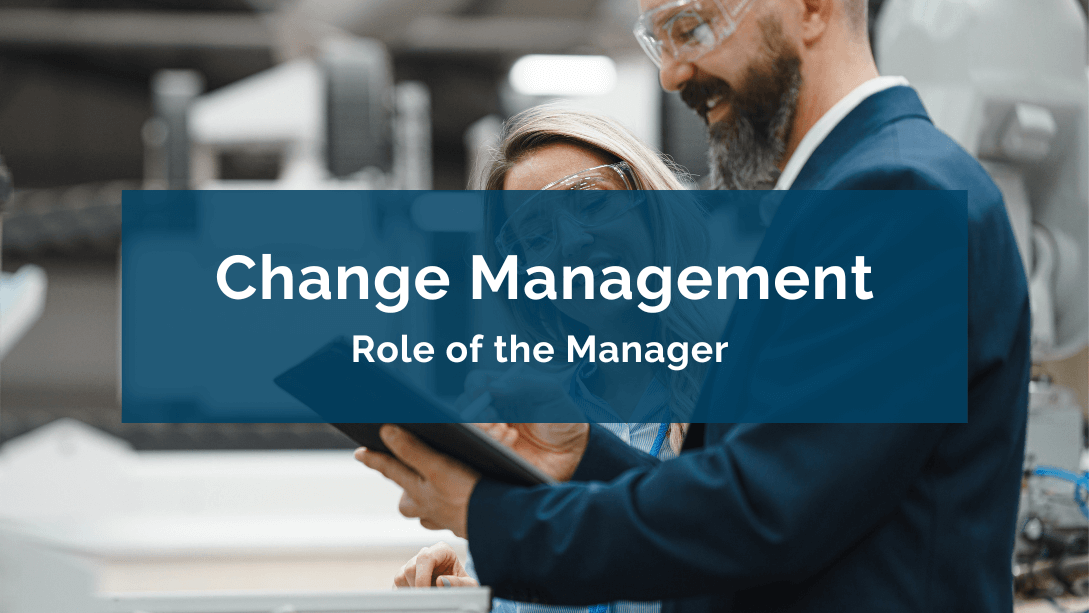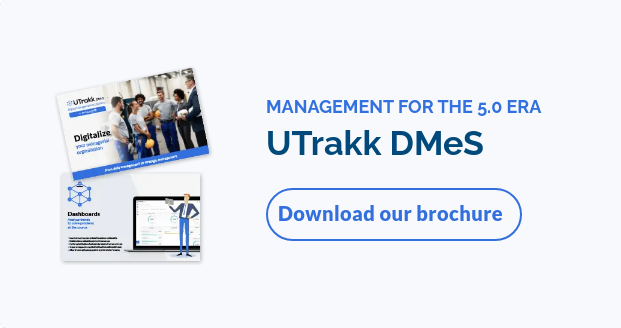A brief overview of change management
Generally speaking, change management involves processes and strategies for managing organizational transitions.
Implementing change is synonymous with considerable challenges in the manufacturing sector, where routine and repetitiveness prevail. It involves updating processes and equipment but also transforming mindsets and skills.
Moving from Industry 4.0 to Industry 5.0: what's at stake for the manufacturing sector?
While Industry 4.0 focuses on machine automation and connectivity, Industry 5.0 goes one step further by reintegrating the human being at the heart of the factory, no longer as a mere operator but as a decision-maker and innovator collaborating synergistically with technologies.
This transition underlines the importance of the individual in the value chain, highlighting the need to develop new, adaptive skills.
As you will have gathered, the transition to new 5.0 technologies involves specific challenges for factories.
Cultural resistance to change
Manufacturing is particularly resistant to change. Attachment to established routines and familiarity with existing processes often leads to employee apprehension when faced with the unknown. They may perceive the change as threatening their job security or fear their current skills becoming obsolete.
Moreover, insufficient communication about the benefits and necessity of change reinforces mistrust and reluctance.
According to a study by Prosci, 70% of change initiatives fail due to employee resistance to change.
Adapting to new technologies
Manufacturing companies must adapt to new technologies to remain competitive, efficient, and innovative. It involves significantly upgrading technical skills, a thorough understanding of new working methodologies, and an ability to interact with increasingly complex systems.
Organizations with successful transformations are likelier than others to use more sophisticated technologies, such as artificial intelligence, the Internet of Things, and advanced neural machine-learning techniques.
Talent and skills management
For this transition to occur correctly, a specific reconfiguration of roles needs to be taken into account, in the sense that humans and machines need to find a dynamic balance for optimal day-to-day collaboration.
As seen above, the rapid evolution of technologies requires highly qualified and adaptable personnel. Companies must attract and retain employees capable of working with advanced technologies, and invest in the training and skills development of existing employees.
The role of manager in change management
Frontline leaders are uniquely positioned to drive organizational change. They possess the practical knowledge of front line employees, combined with a comprehensive understanding of the organization's vision and goals.
Before implementing strategies and changes required by 5.0 technologies, managers must be empowered. Good managers, especially competent frontline managers and supervisors, are crucial in such a situation. With them, the transition is likely to succeed.
To take it a step further, the manager's role is to become a "change manager", an expert in managing and facilitating the change process within an organization. They are the ones who ensure the successful introduction of new technologies, business processes, structures, or strategies.
The change manager has several management responsibilities:
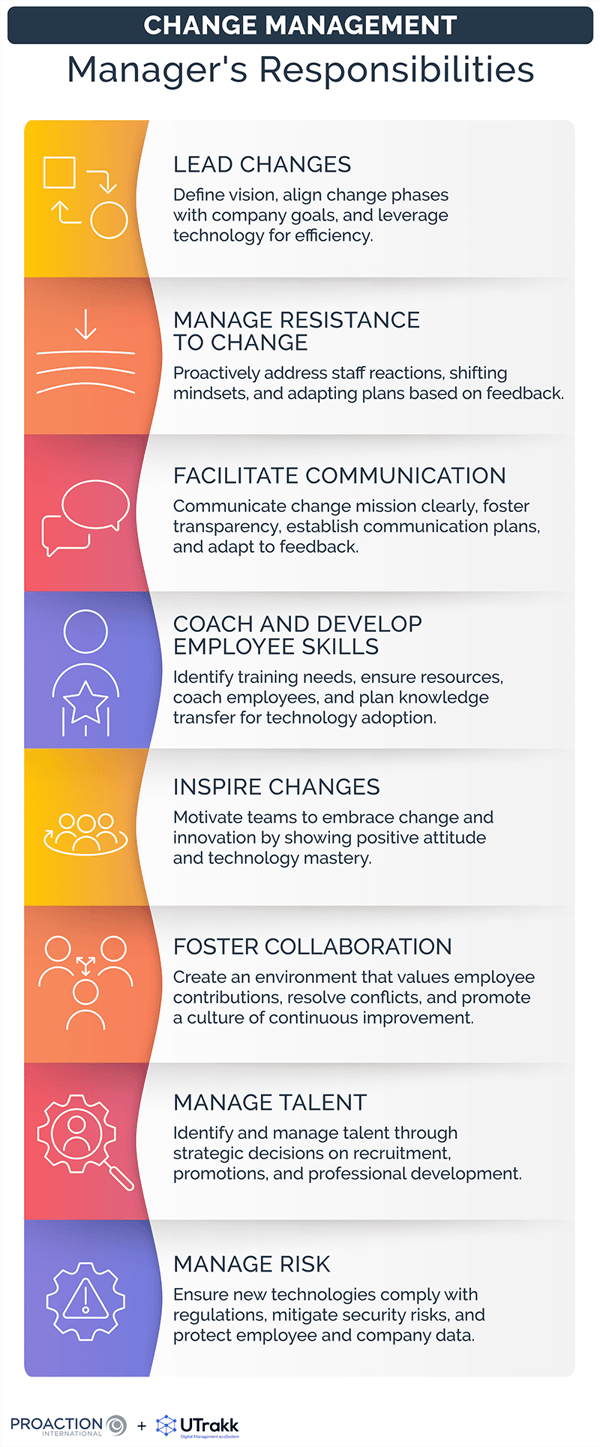
Lead changes
They define the vision and strategy for change. They align the phases of change with the company's overall objectives, identifying how new technologies can improve processes, increase efficiency, and stimulate growth.
Manage resistance to change
Middle managers are often the first to observe staff reactions to change and play a proactive role in managing resistance.
By being directly on the ground, they are best placed to shift mindsets, understand employees' fears, respond appropriately, and adapt the change plan according to feedback from the field.
Facilitate communication
The manager needs exceptional communication skills. They must convey the mission, objectives, expected benefits of change as clearly as possible, and the impact on the various stakeholders.
They must be open and transparent to minimize uncertainty and instill trust in the teams.
They must also establish a solid communication plan between the various hierarchical levels, enabling key messages to be correctly passed down and problems to be escalated.
Change the ways you communicate. Good communication has always been a critical success factor in traditional change efforts, and it is just as important in a digital transformation.
Coach and develop employee skills
With the introduction of cutting-edge technologies, employees must be trained and ready to use new tools and processes during their work. The manager is responsible for identifying training and skills development needs, ensuring that their project team has the necessary resources and feels ready to adopt new technologies.
They must also be able to spot employees who are resistant to change and coach them so that they understand and are comfortable with the new developments.
Perhaps even more important is to plan for the transfer of knowledge from the old operation, in which people knew the materials and the product very well, to the new process, which outsiders may initially design and run.
Inspire changes
The attitudes and behaviors of every manager have a significant impact on team morale and engagement.
A competent manager who demonstrates a positive attitude to change and a mastery of new technologies motivates and inspires their teams to adopt a similar approach.
Foster collaboration
The change manager must create an environment where employees feel valued and able to contribute to the change process. It means fostering collaboration, resolving conflicts, and promoting a culture of continuous improvement.
Manage talent
The change manager's mission in a company is to identify and manage talent to ensure the right people are in place to drive change initiatives. It often involves strategic decisions concerning recruitment, internal promotions, and ongoing professional development.
Manage risk
With the introduction of new technologies, especially those related to data and automation, security and compliance issues are becoming more complex. The manager must ensure that these technologies comply with current regulations and do not compromise the security of employees or company data. They must identify, analyze, and set up risk mitigation tactics.
Having the correct change managers before implementing 5.0 technologies helps ease the transition. It is also a strategic investment to ensure that transformation projects are implemented, adopted, and optimized, thus guaranteeing their success.
How can manufacturing companies support their managers during a change management process?
Leadership is not about being in charge. It's about taking care of those in your charge.
It's not just up to managers. As a company, you, too, have a central role to play in this transition.
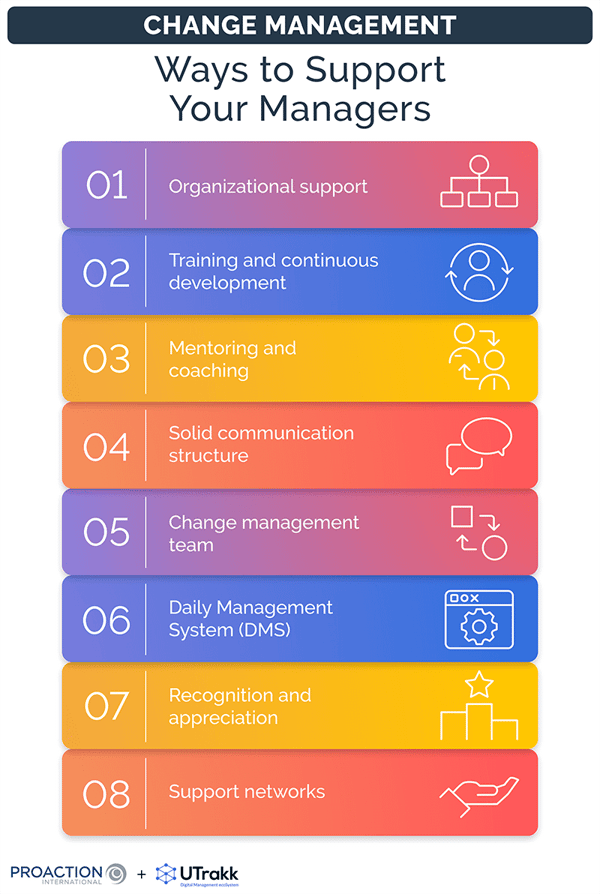
Organizational support
Ensure your managers have the proper support from top management to implement the change. It includes a certain amount of freedom to make decisions and good support in the event of challenges.
Also, consider providing the latest apps and resources that support managers in their day-to-day tasks, such as project management software, communication platforms, and performance management systems.
Frontline leaders must be equipped with the necessary skills and knowledge to drive change effectively.
Training and continuous development
Offer your managers training programs that cover the technical aspects of new technologies and change management skills (communication, leadership, conflict resolution, project management, etc.).
Mentoring and coaching
Set up mentoring programs where senior managers coach new or less-experienced staff.
Individual coaching is also an excellent way for managers to develop their leadership skills and learn to navigate complex situations.
Solid communication structure
Create a solid communication structure to clarify the vision and objectives of change, encourage two-way dialogue for better feedback, and reinforce engagement by offering constant support. This way, your managers will be ready to lead their teams through the necessary transformations.
One change is to move away from traditional channels that support only one-way communication and toward more interactive platforms that enable open dialogues across the organization. Another key to better communication is developing more concise – and even tailored – messages for people in the organization rather than lengthier communications.
Change management team
Set up a change management team responsible for overseeing and facilitating change. It typically includes a change manager, one or more project managers, HR representatives, a communications specialist, IT specialists, and a budget coordinator.
The exact composition may vary, but the goal is a cohesive effort to guide successful organizational change.
Daily Management System like UTrakk
UTrakk is a Daily Management System (DMS) that offers a wide range of powerful features, enabling managers to plan and manage the implementation of changes within the organization:
- Project management: This module facilitates the implementation of changes, ensuring rigorous project management through action plans and daily tasks.
- Rituals: The "Rituals" module enables managers to set up meetings involving all relevant departments, before and during change deployment. Communication streams can also be set to answer employee questions and gather their feedback.
- Checklists: Managers can add control points to their checklists, to follow up on the adoption of new technologies during their field tours.
- Dashboards: Personalized dashboards showing key performance indicators associated with the changes, allow managers to monitor progress and identify potential problems.
- Knowledge Center: This feature digitalizes and centralizes processes, work instructions and best practices, so that teams can quickly access the new standards in place.
Recognition and appreciation
Remember to acknowledge managers' efforts and successes in driving change. It can include formal rewards, promotions, professional development opportunities, or simply verbal recognition of their work.
Support networks
Encourage the creation of support networks or groups where managers can share experiences, challenges, and best practices. It can help create a learning community and a sense of solidarity.
Research from McKinsey points to a set of factors that might improve the chances of a transformation succeeding. These factors fall into five categories:
- Having the right, digital-savvy leaders in place
- Building capabilities for the workforce of the future
- Empowering people to work in new ways
- Giving day-to-day tools a digital upgrade
- Communicating frequently via traditional and digital methods
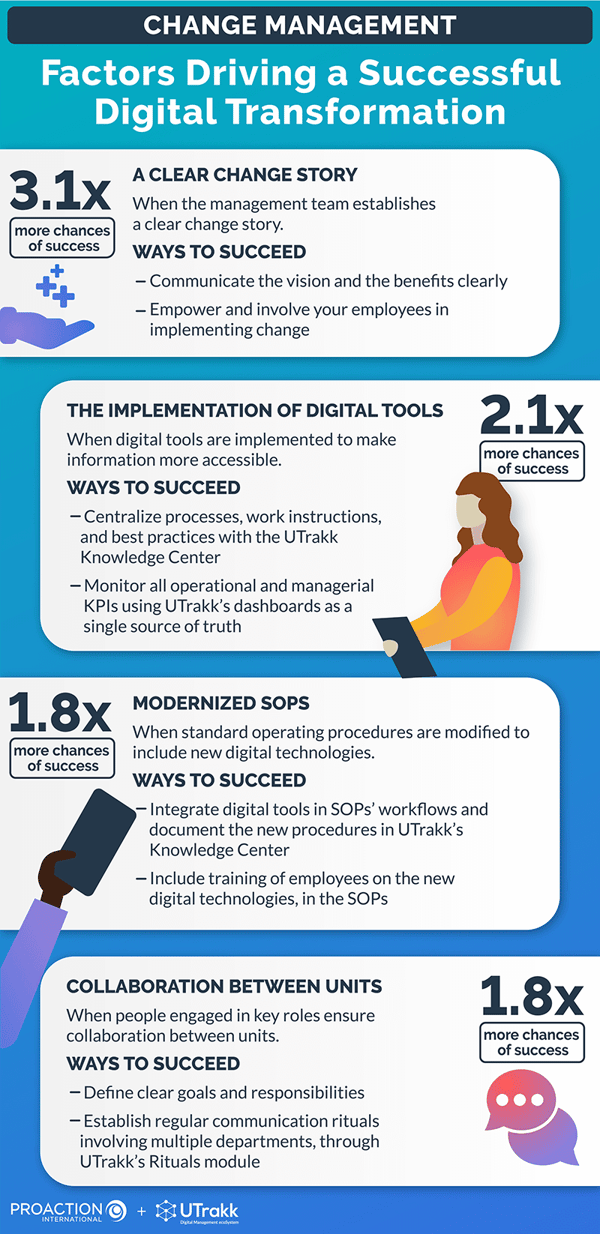
Managers' challenges in implementing new technologies
Technology integration
Integrating cutting-edge technologies with existing systems can be complex. Leaders must manage this technical aspect, ensuring that new solutions work harmoniously with the existing infrastructure without disrupting current operations.
Managing expectations
It's crucial to manage the expectations of all key stakeholders, including upper management, employees, and customers. It involves communicating what the new technologies can achieve, when, and what resources will be needed to achieve these goals.
Monitoring performance and solving problems
Once new technologies are in place, managers must keep a close eye on their performance, quickly identify problems, and intervene to make the necessary adjustments, thus ensuring that objectives are met.
Maintaining productivity
During the transition phase, it is essential to maintain productivity. Managers must plan the implementation carefully to minimize disruption and ensure operations run smoothly.
Working toward excellence: The change manager at the heart of manufacturing transformation
The manufacturing sector is constantly evolving at an ever faster pace. In the transition from Industry 4.0 to Industry 5.0, the role of managers, especially frontline managers, in change management is fundamental. They are the architects of the digital transformation, ensuring that human-machine collaboration is as harmonious as possible. Their ability to communicate, inspire, develop, and guide their teams through the twists and turns of change is essential.
The manager’s role becomes even more critical to ensure the success of transformation plans and the effective implementation of advanced technologies, as they must combine technical expertise with emotional intelligence and the aptitude to manage complexity.
Companies that invest in the development and support of their managers, equipping them with the tools, training, organizational support, and recognition they deserve, put themselves in a prime position not only to grow in the present but also to perform in the future. In the age of Industry 5.0, the real driver of innovation and competitiveness lies in the ability to manage change with agility, insight, and humanity.
If you give every team member in your company a great manager – a great coach – one who cares about their development and growth, you have successfully engineered an organization with unlimited potential.
Gallup, It's the Manager




